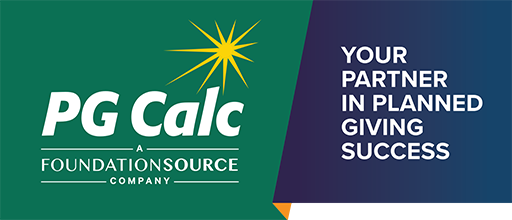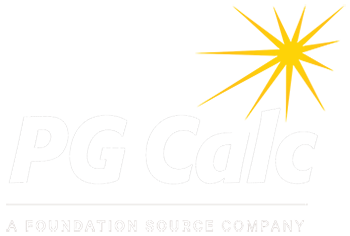Featured Articles
PG Calc publishes monthly articles on the latest topics in planned giving.
Tax Reform Provisions That Could Affect Charitable Giving
-Under Republican leadership, Congress is working feverishly to complete the details of sprawling tax reform legislation, the Tax Cuts and Jobs Act, and have it on President Trump’s desk for his signature by the end of this year. The House bill was voted on and approved on November 16. On the same day, the Senate Finance Committee approved their version of the package.
Revocation Language in CGA Agreements - To Include or Not To Include
-Including revocation language serves two purposes. First, it may enable the donor to avoid making a taxable gift to the annuitant. Second, it preserves flexibility in the event of a change in circumstances, such as the dissolution of a marriage. The decision on whether to include the revocation language is ultimately the donor’s, but it is helpful if the charity understands the issues to help inform that decision.
Surrendering an Income Interest in a Life Income Gift (Including Partial Surrender)
-By their nature, life income gifts (Charitable Gift Annuities, charitable remainder trusts, and pooled income funds) are arrangements where the donor transfers assets now, but delays the charity’s use of the funds until a future date, normally the death of one or more income beneficiaries. A charitable remainder trust can be established for a term of years, but until the expiration of what can be a term of up to twenty years, the assets of the trust are unavailable to charity.
Missing Persons and Uncashed Checks
-One of the most frequent challenges encountered in the administration of life income gifts is the issue of uncashed checks. The typical response to an uncashed check is to place a stop payment on the check after a specific period of time, and to reissue payment in the form of a replacement check. If the replacement check is cashed within a reasonable period of time, it is assumed that the original uncashed check was just an anomaly and no further action is required. But what happens when the replacement check, and subsequent checks are not cashed? This article addresses what a charity should do when a beneficiary stops cashing life income payments.
Funding CGAs with Mutual Funds (What Is the Problem?)
-Mutual funds are easy to purchase, simple to understand, and they allow for continual reinvestment of income over the long run. As planned gift donors review their financial assets and determine which ones to use as the funding for charitable gift annuities, mutual funds present an obvious choice. But gift planners should be aware of some particular aspects of mutual funds that can cause significant complications in the process. Read about the complexities in mutual funds transactions and tax accounting.
Taking the Temperature of Your Gift Annuity Program (And What To Do If It Is Unwell!)
-Fundraisers consider a well-functioning gift annuity program the cornerstone of a robust planned gift fundraising effort. Although bequests and beneficiary designations typically produce most of the realized planned gift revenue, offering gift annuities is usually the mark of a mature planned giving program. Nonetheless, among those charities that have offered gift annuities, many frequently worry about the continued viability of offering them.
Oh, Those Pesky Capital Gains (The Consequences of Capital Gains in Planned Gifts)
-Everyone likes to avoid capital gains – or more specifically, we should say, everyone likes to avoid the taxes on realized capital gains. That’s a given. When an investor sells assets that have appreciated over time, typically there is tax on the built-up appreciation in those holdings, at least by the federal government, and frequently by the state government as well. The owner of the stock reports capital gains even if the owner of the stock uses the sale proceeds immediately to make charitable gifts. On the other hand, if the donor uses appreciated assets for outright charitable gifts, there is no taxation on the long-term appreciation in the holdings.
IRA Charitable Rollover Celebrates First Anniversary
-Since its temporary inclusion in the Pension Protection Act of 2006, Congress has extended the IRA charitable rollover provision in two-year increments through 12/31/2014. Congress did not extend the provision before it expired at the end of 2014. That all changed at the end of 2015 when the House and Senate passed, and the President signed into law, the Protecting Americans from Tax Hikes (PATH) Act. The PATH Act made the IRA charitable rollover permanent. Now is a good time to review the impact of permanent adoption of the IRA charitable rollover on its first anniversary.
Are You Ready for the End?
-The end we are talking about is the end of calendar year 2016. Are you ready? Most charities concentrate on year-end giving in the fourth quarter and for good reason. A study conducted by the Center on Philanthropy at Indiana University focused on high-net worth donors found that 42.7 percent of those surveyed gave more during the holidays than the rest of the year. Nonetheless, in addition to soliciting and encouraging gifts at the end of the calendar year, it is also a time for planned giving departments to prepare and plan.
15 Tips on Getting More Donors to Read Your Emails
-Whenever you prepare a carefully crafted email for your donors, do you have a split second of doubt as you click send that anyone will open it?
I still do after almost 20 years of email marketing.
We can’t help it. There are too many times we have racked our brains for the very best content, the best starting sentence, the best subject line, only to find the email stats show opens aren’t as good as hoped. It happens to all of us, but there are ways to improve the odds of a successful open rate.

